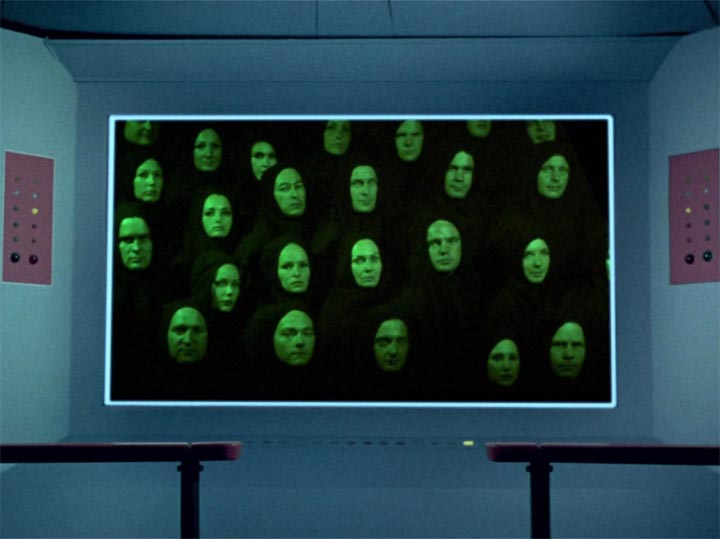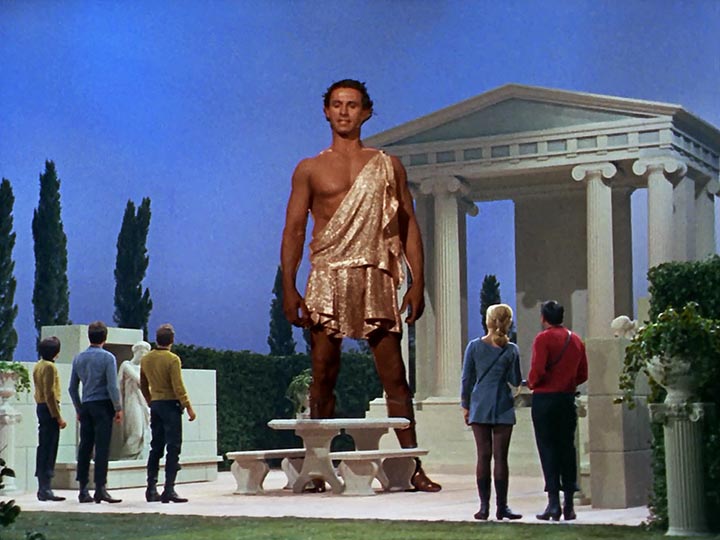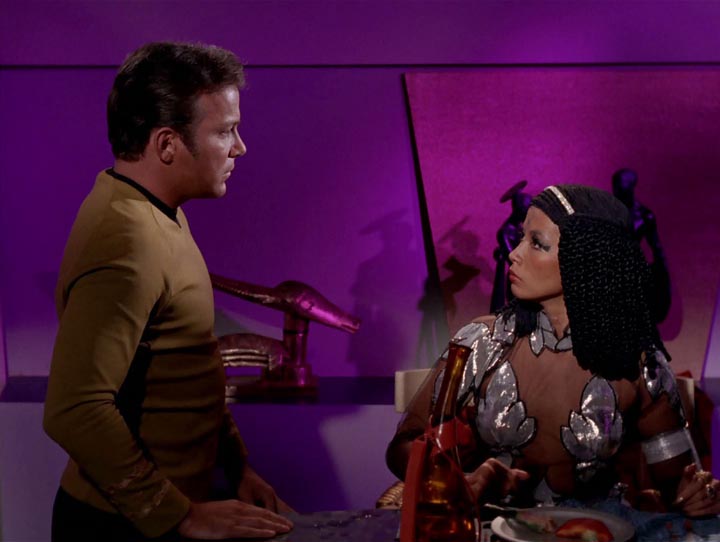Star Trek and the Classical world
I love Star Trek; the original series, in particular. I’ve watched every single episode I don’t know how many times over the past 30+ years. I know most of them by heart and they still never bore me. Captain Kirk, Mr Spock, and Dr McCoy make for excellent company. And for a few years now, I’ve been trying to get my girlfriend to watch the show with me. A couple of months ago, she finally agreed and I figured it would be good to write something about those episodes that draw heavily on the ancient world.
 The original Star Trek ran for three seasons, from 1966 to 1969, and it became incredibly popular in syndication. There was a short-lived animated series in the 70s before a more concerted effort was made to bring the show back to life. However, the success of Star Wars (1977) ensured that what was supposed to have been a new television series – Star Trek: Phase Two – was retooled and changed into a movie, 1979’s Star Trek: The Motion Picture. The rest, as they say, is history.
The original Star Trek ran for three seasons, from 1966 to 1969, and it became incredibly popular in syndication. There was a short-lived animated series in the 70s before a more concerted effort was made to bring the show back to life. However, the success of Star Wars (1977) ensured that what was supposed to have been a new television series – Star Trek: Phase Two – was retooled and changed into a movie, 1979’s Star Trek: The Motion Picture. The rest, as they say, is history.
To boldly go
And for a show set in the future, history looms large in Star Trek. Indeed, while the Enterprise’s mission may have been to ‘explore strange new worlds, to seek out new life and new civilizations’, many of the planets visited by our intrepid crew are quite familiar, and more than one of the new civilizations was derived, in one way or another, from something that was distinctly Earth-like.
Part of this was explained by the creators as ‘parallel evolution’, but I’m not sure that they really understood the concept. A shark and a dolphin are two vastly different animals – one a fish, the other a mammal – that look sort of similar because they both adapted to the same environment. Importantly, they are not identical. But on Star Trek, ‘parallel evolution’ generally meant ‘identical to Earth’ in (virtually) every way. A particular egregious example occurs early in the first season, in the episode ‘Miri’, when the Enterprise comes across a planet that looks exactly like Earth (continents and all), with a city that looks like a typical American city, inhabited by what look like regular humans.
 The writers of Star Trek drew on a large number of sources for inspiration to forge their social (or ‘soft’) science-fiction. In Star Trek, the focus was always on the human element: how would a flawed human being cope with having godlike powers thrust upon him (‘Where No Man Has Gone Before’, ‘Charlie X’)? What role does evil play in forming a person’s character (‘Enemy Within’)? What are the alternatives to waging war (‘A Taste of Armageddon’)? How do people cope with disaster (‘The Galileo Seven’)? Can we understand something that is truly alien (‘Devil in the Dark’)? Just how ridiculous is racism when you think about it (‘Let That Be Your Last Battlefield’)?
The writers of Star Trek drew on a large number of sources for inspiration to forge their social (or ‘soft’) science-fiction. In Star Trek, the focus was always on the human element: how would a flawed human being cope with having godlike powers thrust upon him (‘Where No Man Has Gone Before’, ‘Charlie X’)? What role does evil play in forming a person’s character (‘Enemy Within’)? What are the alternatives to waging war (‘A Taste of Armageddon’)? How do people cope with disaster (‘The Galileo Seven’)? Can we understand something that is truly alien (‘Devil in the Dark’)? Just how ridiculous is racism when you think about it (‘Let That Be Your Last Battlefield’)?
For the plots of many episodes, the writers relied in part on contemporary stories (e.g. overpopulation in ‘The Mark of Gideon’), took inspiration from Shakespeare (‘Dagger of the Mind’, ‘Conscience of the King’), and history (‘The Squire of Gothos’ and too many other episodes to list). It’s no doubt a sign of the greater importance that knowledge of the ancient world had in more remote decades that Star Trek has so many episodes in which classical ideas and stories loom large.
Star Trek and the ancient world
The episode ‘Arena’ suggests gladiatorial spectacle. Kirk chases down a ship that attacked a Federation colony. A powerful alien being interceded and transports the captains of both vessels to a distant world where they have to fight each other to determine which ship will be destroyed and which one will be spared. It’s a memorable episode for pitting Kirk against a man in a lizard costume, but the idea of pitting two individuals against each other is clearly inspired by gladiatorial contests, with the crews of both ships allowed to watch the battle on their viewscreens.
Gladiatorial contests would feature in two more episodes of the original series. In ‘The Gamesters of Triskelion’, Kirk, Uhura, and Chekov are captured and enslaved. They are then forced to train for and take part in battles for the amusement of the Providers, who bet ‘quatloos’ on the outcome of each engagement. It’s a fun episode with some ridiculous costume design. In the final battle, Kirk has to fight a number of opponents and he’s not allowed to step on certain parts of the arena. But if you look closely, you’ll note that William Shatner wasn’t particularly careful in this regard!
 In the episode ‘Bread and Circuses’ , the Enterprise happens across a planet that is again a near-duplicate of Earth, where history apparently also unfolded as on Earth, except that the Roman Empire never fell. As a result, we’re treated to 1960s ‘Romans’ who televise gladiatorial contests. The Romans that are shown in the episode are full-blown Hollywood Romans, complete with plastic-looking armour (and those perennial bracers). Graham Sumner has pointed out to me that the Roman costumes were from the movies The Robe and Demetrius and the Gladiators.
In the episode ‘Bread and Circuses’ , the Enterprise happens across a planet that is again a near-duplicate of Earth, where history apparently also unfolded as on Earth, except that the Roman Empire never fell. As a result, we’re treated to 1960s ‘Romans’ who televise gladiatorial contests. The Romans that are shown in the episode are full-blown Hollywood Romans, complete with plastic-looking armour (and those perennial bracers). Graham Sumner has pointed out to me that the Roman costumes were from the movies The Robe and Demetrius and the Gladiators.
The Enterprise comes face to face with a powerful alien being who identifies himself as the god Apollo in ‘Who Mourns for Adonais?’ He is the last of an alien race of beings who lived on Earth as the Olympian deities thousands of years ago, with Zeus, Hera, and the others already scattered to the cosmic winds. This is also the only episode to feature the Enterprise’s A&A Officer (Archaeology & Anthropology), which suggests that at least in the 23rd century, the humanities and social sciences receive ample funding.
 ‘Adonais’ (or rather, ‘Adonaïs’) is a reference to the poem by Percy Bysshe Shelley, composed on the death of John Keats. It is modelled after ancient elegies and deals with the untimely death of Adonis (in the book, The Making of Star Trek by Stephen E. Whitfield, the episode is erroneously referred to as ‘Who Mourns for Adonis?’ ). The plot of the episode is as melancholy as the poem. Apollo is the only one of his species that still clings to life, but once he realizes that he is no longer needed, he too scatters himself. The episode derives the title from the opening of stanza 47:
‘Adonais’ (or rather, ‘Adonaïs’) is a reference to the poem by Percy Bysshe Shelley, composed on the death of John Keats. It is modelled after ancient elegies and deals with the untimely death of Adonis (in the book, The Making of Star Trek by Stephen E. Whitfield, the episode is erroneously referred to as ‘Who Mourns for Adonis?’ ). The plot of the episode is as melancholy as the poem. Apollo is the only one of his species that still clings to life, but once he realizes that he is no longer needed, he too scatters himself. The episode derives the title from the opening of stanza 47:
Who mourns for Adonais? Oh, come forth,
Fond wretch! and know thyself and him aright.
Clasp with thy panting soul the pendulous Earth;
As from a centre, dart thy spirit’s light
Beyond all worlds, until its spacious might
Satiate the void circumference: then shrink
Even to a point within our day and night;
And keep thy heart light lest it make thee sink
When hope has kindled hope, and lured thee to the brink.
In ‘Plato’s Stepchildren’, the Enterprise come across a planet inhabited by sadistic people who claim to have modelled their society after ancient Greece, and the philosophy of Plato in particular. These ‘Platonians’, as they refer to themselves, are telekinetic, able to control other beings through their minds, and they derive great pleasure in tormenting Alexander (Michael Dunn), a dwarf. The sets and costumes are Hollywood versions of ancient Greece and one wonders what Plato himself would have made of the Platonians. Graham Sumner tells me that actor Michael Dunn is also known for appearing as General Narses in Kampf Um Rom (i.e. Battle for Rome).
 Sometimes, the classical influences are less on the nose or mixed up with other, non-classical elements. A good example is the episode ‘Elaan of Troyius’. The Enterprise has to pick up a spoiled princess, Elaan (Helen), from the planet Elas (i.e. Hellas: Greece) and transport her to Troyius (Troy), where she will marry the king to bring peace between the two warring worlds. As might be obvious, the story is inspired by the events of the Trojan War, though the plot is more similar to Shakespeare’s The Taming of the Shrew. As in Shakespeare’s play, Elaan is obstinate and needs to be ‘tamed’ to turn her into a willing bride. In the episode, Kirk takes on the role of Petruchio, except that he prepares her for marriage with the ruler of Troyius.
Sometimes, the classical influences are less on the nose or mixed up with other, non-classical elements. A good example is the episode ‘Elaan of Troyius’. The Enterprise has to pick up a spoiled princess, Elaan (Helen), from the planet Elas (i.e. Hellas: Greece) and transport her to Troyius (Troy), where she will marry the king to bring peace between the two warring worlds. As might be obvious, the story is inspired by the events of the Trojan War, though the plot is more similar to Shakespeare’s The Taming of the Shrew. As in Shakespeare’s play, Elaan is obstinate and needs to be ‘tamed’ to turn her into a willing bride. In the episode, Kirk takes on the role of Petruchio, except that he prepares her for marriage with the ruler of Troyius.
Finally, there are also a few episodes inspired by the bible. ‘The Apple’ obviously refers to the apple of knowledge that led to the loss of innocence and the expulsion from paradise. In the episode, the Enterprise destroys the computer (‘Baal’) that controls a native population and frees them to follow their own path. In ‘Requiem for Methuselah’, the crew meets a man called Flint who is actually an immortal, born thousands of years ago in Mesopotamia and who made his mark on history under the names of Solomon, Alexander, Leonardo Da Vinci, Johannes Brahms, and so on.
Closing remarks
That will do it for this brief foray into the classical influences on my all-time favourite television series. I’ve written earlier about how history informs our modern world, and especially how it has influenced our popular culture. For this purpose alone, the study of history is useful, not only in understanding modern art and culture, but in creating it, too. On my personal blog, I wrote a brief piece on modern takes of the Aeneas story, which might be of interest to you.
Also remember that every issue of Ancient Warfare features an article in the series ‘Hollywood Romans’, written alternately by David L. Reinke and Graham Sumner. If you’re interested in their views on movies and television shows set in the ancient world, why not order the latest issue or take out a subscription, if you haven’t already?
Picture credits: photos taken from the internet. Star Trek is owned by CBS Studios, Inc.

